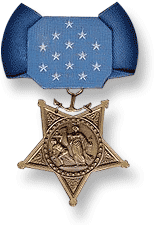Thomas James Reeves
| Thomas James Reeves | |
|---|---|
.jpg)  Chief Radioman Thomas J. Reeves | |
| Born |
December 9, 1895 Thomaston, Connecticut |
| Died |
December 7, 1941 (aged 45) KIA at Pearl Harbor, Hawaii |
| Allegiance |
|
| Service/branch |
|
| Years of service |
1917 – 1919 (Navy Reserve) 1920 – 1941 (Navy) |
| Rank | Chief Radioman |
| Unit | USS California (BB-44) |
| Battles/wars | |
| Awards | Medal of Honor |
Thomas James Reeves, born in Thomaston, Connecticut, December 9, 1895, was a US Navy radioman who became the namesake of the destroyer escort USS Reeves. Reeves was killed during the Japanese surprise attack on Pearl Harbor on December 7, 1941, and posthumously received the Medal of Honor.
Military service
Thomas Reeves enlisted in the United States Naval Reserve as Electrician third class on July 20, 1917. Released from duty July 21, 1919, he was recalled to active duty and was transferred to the regular Navy April 16, 1920 and served until discharged August 21, 1921. On October 12, 1921 he re-enlisted in the Navy making it his career.
Advanced through the rates to chief radioman, Reeves was serving in the battleship USS California (BB-44) when the Japanese attacked Pearl Harbor, December 7, 1941. During that attack the mechanized ammunition hoists in the battleship were put out of commission. Reeves "... on his own initiative, in a burning passageway, assisted in the maintenance of an ammunition supply by hand to the antiaircraft guns until he was overcome by smoke and fire which resulted in his death." For his distinguished conduct, RMC Reeves posthumously received the Medal of Honor.
Namesake
In 1943, the destroyer escort USS Reeves (DE-156) was named in his honor.
Medal of Honor citation
Citation:
For distinguished conduct in the line of his profession, extraordinary courage and disregard of his own safety during the attack on the Fleet in Pearl Harbor, by Japanese forces on 7 December 1941. After the mechanized ammunition hoists were put out of action in the U.S.S. California, Reeves, on his own initiative, in a burning passageway, assisted in the maintenance of an ammunition supply by hand to the antiaircraft guns until he was overcome by smoke and fire, which resulted in his death.
See also
References
- This article incorporates text from the public domain Dictionary of American Naval Fighting Ships.
- "Congressional Medal of Honor Society". Retrieved October 5, 2010.
External links
- "Thomas James Reeves". Claim to Fame: Medal of Honor recipients. Find a Grave. Retrieved 2007-12-13.